Tour & Design
The Sennheiser CX 680is are a set of portable in-ears with a remote and mic.
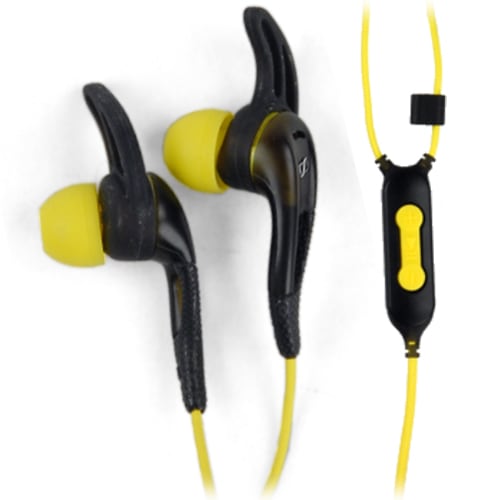
The ear buds have a slightly atypical design, in that they have a little rubbery claw that sticks up vertically. This should rest neatly in your concha, fitting just under your helix. Sennheiser calls them EarFins, but that's not very specific and sounds like more like a genetic defect than a headphone form factor. We're therefore going to exercise our journalistic powers and dub them helix fins. We would've called them concha grips, but "concha" isn't a very elegant-sounding word and the phrase wouldn't have any assonance. These are things you have to consider when you're a superstar headphone reviewer.
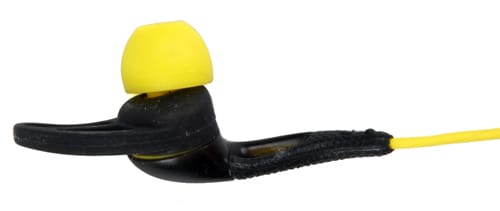
The remote & mic are located at the neck split, and are encapsulated in a bit of black plastic. The controls themselves are a yellow bone-shaped bit of rubber. The top node is volume up, the bottom is volume down, and the space between them controls playback (one click to pause/unpause, two to forward skip, and three to reverse skip). The control pendant doesn't have particularly good cord guards, so this is a weak point in the cable.
Oh and also there's a little clip there to shorten or lengthen the neck split. Without this clip, you wouldn't be able to ensure the cable is synched just tightly enough to follow every contour of your chin and throat without causing discomfort. We know a lot of you really value this experience.

The headphones end in a standard 1/8-inch plug. It's very skinny, which is great for connecting to a first-generation iPhone or a device with a recessed port.

But who is that handsome fellow? Why, it's none other than our head and torso simulator, or HATS. Today he's sporting the CX 680is. This is exactly what you'll look like if you wear these headphones, providing you're gray and featureless with removeable ears and robot parts, but that's likely not the case because then you woudn't have eyes and couldn't see this.
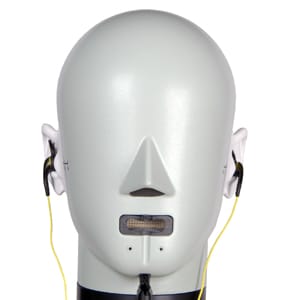
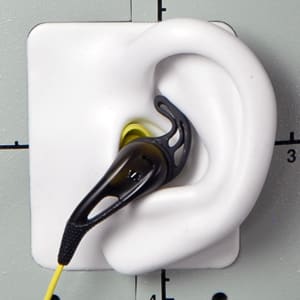
In The Box
In the 680i's box you'll find the heapphones themselves, a shirt clip, a cleaning tool, two extra sleeve sizes, two extra helix fin sizes, and one set of non-finned bits. There's also a carrying case brought you to ADIDAS, manufacturer of fine headphone carrying apparel.
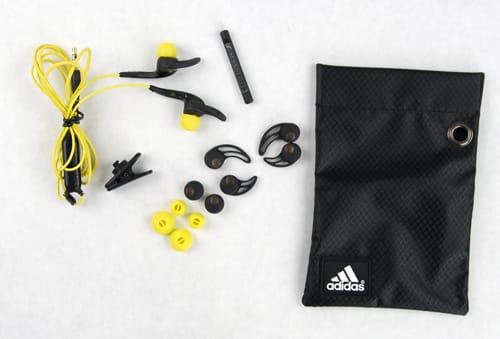
Like most in-ears, the Sennheiser CX 680is aren't long for this world. They're mostly cable, and not particularly well-insulated cable at that. You're also more likely to just ball up the cord and shove it into your pocket, which can cause a lot of internal wear and tear.
Yellow is the "It" color this season, and the CX 680is sport it with style. Their sleek appearance and porpoise-like dorsal fins are taking the fashion world by storm, but since dorsal fins are mainly intended to help marine life maintain their balance in rough seas, I don't think anyone should be too worried about this storm.
Sound Quality
About our testing:
For more information on our tests, read this article.
**Frequency Response** (*6.76**)*
What we found:
The Sennheiser CX 680is didn#39;t have a great frequency response, but it wasn#39;t terrible either. First of all, the bass is somewhat overemphasized. While this isn#39;t a strange feature for a set of headphones, the boost is a bit excessive compared to the rest of the response curve: it#39;ll drown out other frequencies. More troubling, however, is the lack of uniformity between the left and right channel. Those two curves should be directly on top of each other, ensuring each ear is receiving the same output. After the 1kHz mark, however, the left channel gets a bit louder than the right. This isn#39;t a chart the CX 680is#39; mom would want to put up on the fridge. In fact, the CX 680is probably wouldn#39;t even tell their mom about it: they#39;d probably just try to do well on the other performance tests and hope it#39;s enough to bring up their final overall ranking.
How the Sennheiser CX 680i compares:
How does this test work?
**You can read more about our frequency response test on our How We Test page.
**Distortion**nbsp;nbsp;nbsp;nbsp; (10.80*)*
What we found:
The CX 680is really didn#39;t have any distortion worth talking about. For all intents and purposes, they#39;re distortion free. Sennheiser headphones might not be perfect in many areas, but they very, very rarely have issues with distortion, even at the lower-end of their product line-up.
How the Sennheiser CX 680i compares:
How does this test work?
**You can read more about our distortion test on our How We Test page.
**Tracking**nbsp;nbsp;nbsp;nbsp; (5.56)
What we found:
The headphones had some issues with tracking, as we mentioned earlier. The left channel gets louder over as the frequency increases. The progression is pretty smooth, however, so the imbalance shouldn#39;t be jarringly noticeable.
How the Sennheiser CX 680i compares:
How does this test work?
**You can read more about our tracking test on our How We Test page.
nbsp;
Isolation
**Maximum Usable Volume** (9.00)
What we found:
The Sennheiser CX 680i headphones can output up to 115.80dB without reaching a noticeable distortion level (3%). We award maximum points for 120dB, since anything louder than that is just harmful to your ears. The CX 680is just about reach this threshold, so you shouldn't have any issues with your playback not being loud enough.
This doesn't mean the CX 680is decibel output is capped at 115.9dB, just that anything louder will have a noticeable amount of distortion. While this might not be an issue for music that already heavily imploys distortion filters on their instruments, it will be more noticeable in, say, a live opera recording.
How does this test work?
**You can read more about our maximum usable volume test on our How We Test page.
What we found:
The Sennheiser CX 680is aren#39;t the greatest isolators, but they aren#39;t terrible either. Some people like hearing a bit of ambient noise when they have their headphones in, so they can hear any trains sneaking up on them. If you fall into this category, the CX 680is are a great pick! If you really want to block out external noise, however, there are better options out there.
How the Sennheiser CX 680i compares:
How does this test work?
**You can read more about our isolation test on our How We Test page.
**Leakage**nbsp;nbsp;nbsp;nbsp; (*6.98**)*
What we found:
The Sennheiser CX 680i headphones don#39;t leak much, but they aren#39;t dead silent either. You shouldn#39;t run into problems during normal use, but if you listen to loud music in a relatively quiet place, those around you will definitely be able to hear your playback.
How does this test work?
**You can read more about our leakage test on our How We Test page.
nbsp;
Comfort

We didn't have any issues with the Sennheiser CX 680i headphones' comfort level. They're just as comfortable as any other set of in-ears, and their helix fins help keep them in place. The headphones would still function just fine if they didn't have the fins, which is important. Those helix fins only go so far to hold a set of headphones in, and more often than not they just make it harder for the heapdhones to totally pop out of your ears: they don't do much to prevent the headphones from falling out of place. Compare the CX 680is to the Bose MIE2s, which really don't stay in your ear well without the fins.
The CX 680is didn't really get more or less comfortable over time. That's the true sign of well-made in-ears. If the fit isn't great, the sleeves can cause discomfort over multiple hours of wear. We really didn't find this was the case. We never forgot we were wearing the headphones, but we never felt uncomfortable either.
**Customizability** (*4.00**)*
As you can see in the shot below, the CX 680is have a few different sleeve options. You get two additional sizes of helix fin, and two additional sizes of sleeves. Other than that, there isn't a lot you can do to customize your wear experience.

Usability
**Cable Connectivity** (4.16*)*
The Sennheiser CX 680i headphones' cable is just shy of four feet in length. This is a pretty ideal length for a set of in-ears: any shorter and they wouldn't make it to your front pocket, any longer and the cord would be a bit cumbersome. The cable ends in a standard 1/8-inch plug and the headphones don't come with any adapters.

As in-ears, the CX 680i headphones are imminently portable. They're mainly a short length of thin-gauge cable with some plastic bits at the end. They're easy to just ball up and toss in a pocket or bag, and they come with a pouch by ADIDAS that keeps everything nice and neat—and trendy! Other headphones might not come with such a high-end brand name on their pouch, so you should really write Sennheiser a "Thank You" card for being so generous.

The headphones come with a small cleaning tool, which is just a tiny plastic stick with a wire hoop on its end.
Battery Dependency
The Sennheiser CX 680is don't require any batteries. Since batteries are annoying and require additional maintenance, we award any battery-free set of headphones some points.
Remote & Mic
The CX 680is have a remote and mic at their neck split. The controls themselves are two rubbery circles joined by a straight bar. The two circles are volume toggles and the bar is the control. You can use the remote and mic to take phone calls or control media playback.
Bose MIE2 Comparison
Juxtaposing the Bose MIE2s and Sennheiser CX 680is is like a study in helix fins. Both headphones feature similar designs, but the CX 680is just execute that design better. While the CX 680is use them to augment their fit, the MIE2s rely on them to keep the ear buds in place.
The MIE2s have a less consistent frequency response.
Neither set of headphones had any notable distortion.
The CX 680is and MIE2s had opposite tracking problems. The MIE2s issues weren't as pronounced.
The CX 680is isolated much more external sound.
The CX 680is stuck in our ears much better than the MIE2s.
The MIE2s aren't bad headphones, but they're priced out of their class. If you're looking to save some money and get arguably better audio quality and a less-debateably better wear experience, pick up the CX 680is.
Etymotic Hf3 Comparison
The hf3 headphones might look a bit boring, but we're sure they'd prefer the term "minimalistic." The main difference between the two isn't a durability issue, but rather how each impliments their remote & mic. The hf3s have a better position for their remote & mic, placed high up on the left ear bud's cable. The CX 680i's control is a bit lower, which makes it a bit awkward if you have a bag slug between your shoulders: the strap will push its buttons. We liked the CX 680i's button style better, however, as they're a lot easier to use without looking. The hf3 has three identical buttons, and it's easy to accidentally hit the wrong one.
The hf3s underemphasized the high end but didn't over-emphasize the low end like the CX 680is did. The hf3s also have much more consistency between their left and right channels.
No real distortion issues here, though the hf3 has slightly more in the middle of the frequency spectrum.
The hf3s have a much more even tracking.
The hf3s isolate a lot more bass than the CX 680is.
We thought both headphones were about the same in terms of comfort, though if you're used to in-canal earphones, the hf3s will probably feel like a better fit.
This is a rough match-up since the two headphones are so similar. We're leaning towards the hf3s on this matchup because they're more compact, have a much more consistent audio quality, and have better placement for their remote and mic. Really, though, the differences are minor and their price point is roughly the same: try both out before making a final decision.
Shure SE535 Comparison
There's no real competition here: the SE535s feature a much better design than the CX 680is. Their cable detatches from the ear buds to allow inline accessories and to easily replace a broken cable.
The Shure SE535s had a significantly more consistent frequency response.
Neither set of headphones had many isues with distortion.
While the CX 680is' tracking wasn't exactly all over the board, the SE535s were much more balanced.
The Shure SE535s isolate much more external noise.
We didn't really think either set of headphones was more comfortable than the other, but their wear styles are pretty different. The SE535s are meant to be worn with the cable draped around the back of the ear. The CX 680is feature a more traditional wear style. We'd recommending trying out each before making a final purchasing decision.
This match-up is really an issue of budget. Both are good headphones within their respective price points, but those price points are pretty far apart. If you dont' mind taking a hit in durability and sound quality for quite a bit of savings, the CX 680is are the better choice. If you'd rather make the investment up front and not have to deal replacing the entire set of headphones when something breaks down, the SE535s are for you.
Sennheiser CX 980 Comparison
The Sennheiser CX 980s have a pretty unique look to them, but we're not sure if that's a good or bad thing: their odd aesthetics and needlessly fancy plug are simply things to consider. In terms of durability, both headphones seem about equally matched.
It's not really much of a surprise, but the two Sennheiser headphones had very similar frequency responses.
Neither set of headphones had any issues with distortion. No problems here.
Both headphones have the same "it's good, not great," brand of tracking. The CX 680is had a more gradual shift in volume while the CX 980s had a more sudden, more compartimentalized shift.
The CX 980s blew the CX680is out of the water with tracking. If you need isolation, check out the CX 980s.
We thought both headphones were roughly the same level of comfortable. The CX 680is have the optional helix fins to help keep the heaphones in place, but otherwise the two headphones aren't very different. The one minor complaint we'd make regarding the CX 980s is that their control pendant is a bit bit for the limited functionality it provides (just volume control).
The CX 680is are definitely the budget option of the two, but there's nothing about the sound quality or construction of the CX 980s that really justifies such a large price difference. If you want high-end headphones, the CX 980s are the better bet, but at their price there are other
Conclusion
Meet the tester
Mark Brezinski works on the Home Team, reviewing refrigerators, minifridges, dishwashers, washing machines, dryers, air conditioners, air purifiers, and fans.
Checking our work.
Our team is here to help you buy the best stuff and love what you own. Our writers, editors, and experts obsess over the products we cover to make sure you're confident and satisfied. Have a different opinion about something we recommend? Email us and we'll compare notes.
Shoot us an email